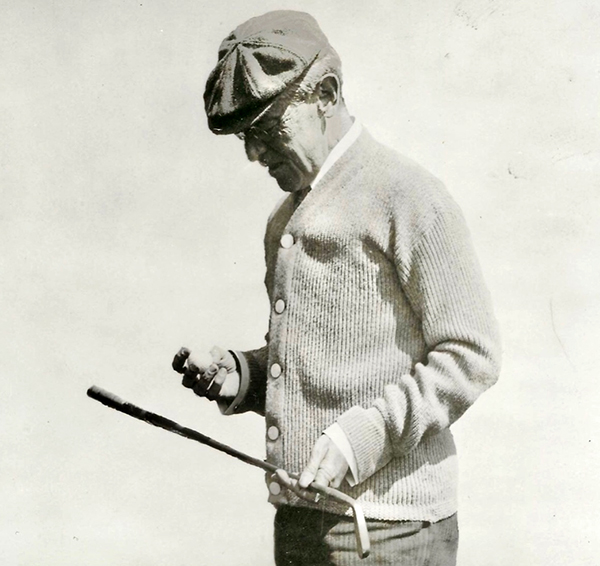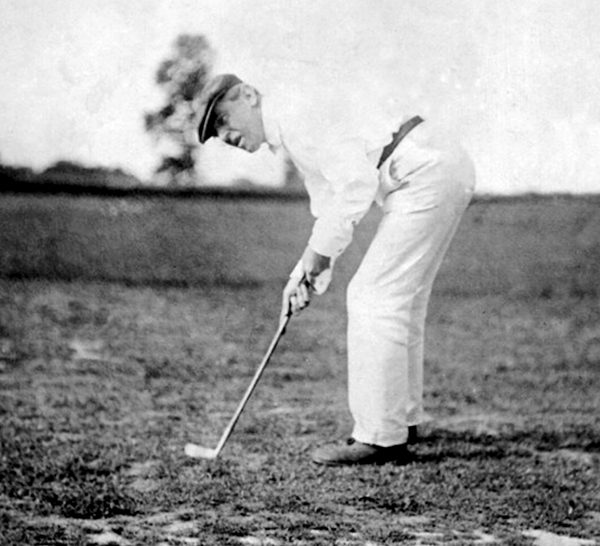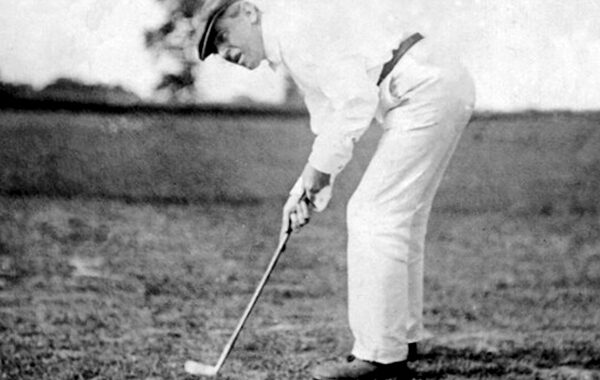Mention that the president of the United States is on the golf course, and you’ll get a standard reply: from the president’s supporters, “Great, he needs time away from the pressures of the job”; from the president’s detractors, “There he goes again wasting time on a frivolous golf game when he should be paying attention to his job.” This article is about the U.S. president who played the most golf while in office…at least until now. Records are made to be broken. The answer may surprise you.
By John Fischer III
We all know that former President Trump was an avid golfer having played about 310 rounds of golf during his term in office. President Joe Biden is also a golfer, and a pretty good one at that, sporting a handicap index of 6.3 a few years ago. And Biden didn’t start playing until 20 years ago when he was 57.
That’s pretty old to take up the game, but the president who played the most golf of anyone to hold the office didn’t start playing golf until after he was in office at age 55. That was our 28th president, Woodrow Wilson. It wasn’t that Wilson suddenly had a desire to play golf, which was still relatively new to the United States, he was told to by the White House physician, Dr. Cary T. Grayson, a doctor in the U.S. Navy.
Dr. Grayson and Wilson had not known each other prior to Wilson’s taking office, but Grayson had served both prior presidents Theodore Roosevelt and William Howard Taft as physician on board the presidential yacht Mayflower, a 275-foot steam powered luxury vessel.
When he first met Wilson, Dr. Grayson recognized that the new president was not in the best of health, and suggested that Wilson spend time outdoors in the fresh air daily and walk. While Grayson was not a golfer himself, he instructed Wilson to take up the game as a tonic. Wilson put his faith in Grayson who had successfully tended to Wilson’s sister when she suffered a small laceration. Wilson took up the game.
Wilson was born in Virginia in 1858, but spent his youth in Augusta, Ga., before it became a winter golfing mecca. He went to Davidson College, studied law at the University of Virginia, got a degree from Princeton and then a doctrate from Johns Hopkins. While he was an excellent student, Wilson also played football and baseball, and rode horseback.
Wilson became a professor after a brief period as an attorney in Atlanta, teaching at several colleges before accepting a position at Princeton and eventually becoming president of the university. He wrote several well regarded books on politics and government and in 1908 won the race for governor of New Jersey as a Democrat with a margin of victory of 65,000 votes, while Taft carried New Jersey in the presidential contest by a margin of 82,000 votes. Four years later, Wilson would defeat Taft for president.
Dr. Grayson was on target with his assessment of Wilson’s health. In 1906, Wilson awoke unable to see out of his left eye. He’d had a retinal hemorrhage and, while he recovered some sight in the damaged eye, he’d lost peripheral vision. As a young man Wilson had weakness or fatigue of the eyes and dimming of vision. This event was probably a small stroke.
Wilson also suffered from headaches, high blood pressure and arteriosclerosis.
So when Dr. Grayson suggested golf, Wilson went forward with the game, and initially it was like a bitter pill — something he had to take even though he didn’t want to. As soon as he took up the game, others wanted to join him. In spite of his austere look, formal attire and a pair of pince-nez glasses perched on his nose, Wilson was a friendly man and enjoyed the company of individuals he knew, but he soon found as president people wanted to play golf with him to catch his ear on matters of state or politics, and he very quickly limited his golf to rounds with Dr. Grayson.

They soon developed a daily routine. Wilson would have breakfast at 8 o’clock and then he and Grayson would head to a golf course to play golf, usually just nine holes during the week, 18 holes on Saturday, and never on Sunday. Wilson came from a line of Presbyterian ministers and never missed Sunday services.
Those rounds were were played regardless of weather. Wilson played golf in the rain and cold weather, having the secret service paint golf balls red so he could play in the snow without losing his ball. He and Dr. Grayson were usually followed by President Wilson’s personal bodyguard and head of the White House secret service, Joseph Murphy, while two other secret service men stayed at the clubhouse.
For all the golf Wilson played, he never became a good golfer. His score was said to be around 115 for 18 holes, and Dr. Grayson was the same caliber player. They had good games against each other and both were serious about topping the other in a match.
They never hung around the clubhouse after golf. Wilson didn’t drink any alcoholic beverages, drink coffee, smoke or play cards, other than solitaire, so it was golf and then back to the White House and presidential duties.
Although he had other patients, Dr. Grayson lived at the White House and knew his number one patient well. Wilson was a focused worker and liked to work at one thing at a time. He threw himself into matters of state and gave everything careful consideration. Grayson knew no one could keep working that way, and golf provided a needed break.
But Wilson’s ways followed him to the golf course. “Each stroke requires your whole attention and seems the most important thing in life,” Wilson said about his game. It took him away from his work, but his intense focus just shifted to golf. At least each round ended with a win, loss or draw without national or international consequences.
In late December, 1913 Dr. Grayson diagnosed Wilson with a terrible cold and recommended a trip to a warmer climate. Pass Christian, Miss., was the destination, located on the Gulf of Mexico near Biloxi, and Wilson rented a house known as Beaulieu instead of going to a hotel or resort so he could rest without having to deal with those outside his family and Dr. Grayson.
There was rest with no presidential business and golf every day, except Christmas day and Sundays, on a 9-hole course a 15-minute drive from the rental home. The promised warm weather didn’t hold for the trip and some days the temperature was in the 40s, but golf went on. All requests to meet with groups in the area were politely declined until the day before they left, when a crowd of 6,000, including a confederate general in full uniform and a former slave who had been Jefferson Davis’s man servant, gathered in front of Beaulieu to wish Wilson fair well.
On the golf course, Wilson was described as not Wilson the president, or Wilson the college professor, but just plain old Mr. Wilson who came to play golf. He asked no special favors and felt that all club rules applied equally to him as they did to others. Other than Dr. Grayson, few people, knew Mr. Wilson the golfer, but one did: Donald Ball, a transplanted Englishman who was the professional at Washington Golf Club in Arlington, Va., just across the Potomac.
“Wilson was just a good fellow when he came on the links,” said Ball. “He forgot all about his office duties and just came out to enjoy himself. He and his friend and physician, Dr. Grayson, always came together and they had some hot games, I’ll tell you. Both of them shot the course somewhere around 90. There was nothing snobbish about Wilson. He was just the same as you or I. He was always jolly. When he sliced his ball into the rough he took it all as part of the game and never complained.
“He would always ask where his friend, Donald, was if he didn’t see me when he started out. That’s the kind of man he was. If he’d see me giving a lesson down on the course, he’d always waive before he went on….Both [Grayson] and Wilson dressed like you and I. They were hardly noticed on the links, so quiet were they. Everybody got excited when they recognized the president. They wanted to put up the flag every time he came on the course but I told them that was just what the president didn’t want. Somebody would come up to me all excited and say, ‘There comes the president.’ I’d tell them, ‘Let him come. There’s lots of room for him.’”
Because Grayson and Wilson always played as a twosome, there’re not a lot of stories about the 28th president on the golf course. Unlike Wilson’s predecessor, William Howard Taft, who talked a lot about golf and was heavy set with a large handlebar mustache the cartoonists loved, the press didn’t focus much on Wilson and his golf. They viewed it as part of a health regimen prescribed by his doctor.
But the unseen caddies were there, and they always have the best unfiltered analysis. Most caddies said Wilson played a good or fair game of golf scoring in the 100s for 18 holes, and that’s probably an accurate analysis of the average player’s game at the time. But they noted that a good drive for Wilson was 120 yards and that his putting was horrible. Wilson’s poor putting was probably due in part to his poor eyesight. It was reported that Wilson took 15 putts on one hole. Because of his lack of peripheral vision in his left eye, Wilson complained he couldn’t see the putter head when he started his stroke back (most would think that a benefit).
One caddie reported that after Wilson had flubbed a shot and was left a mashie iron to the hole, Wilson instead took his 3-wood, caught the ball squarely and it flew over the green. Instead of being upset that he’d left himself in a poor position, Wilson was delighted that he’d hit the ball so well.
Wilson was considered a “good loop” by caddies. He treated them with courtesy and didn’t complain about their services. And caddying for the president carried a special honor. Caddies noted, however, he only paid the going caddie rate, 25 or 35 cents for 18 holes. No big tips.
In August, 1914, President Wilson’s wife, Ellen, died from Bright’s Disease, a kidney ailment. Wilson was devastated, and golf stopped for a while, but by the fall the president was back on his routine.
In March, 1915, the president and Dr. Grayson returned to the White House from a round of golf in inclement weather, their shoes and clothing wet and covered in mud. They were met by Wilson’s cousin, Helen Bones who was acting as substitute First Lady at the White House, and her friend Edith Galt, a widow. Wilson and Grayson got cleaned up and had tea with the ladies. For Wilson, it was love at first sight. He was smitten with Edith Galt.
During their courtship, Wilson played golf with Mrs. Galt and Dr. Grayson. She played about the same as Wilson and Grayson, although some thought she was actually better than either of the two men.
Wilson and Edith Galt were married a week before Christmas, and the new couple honeymooned at the Homestead in Hot Springs, Va. where they played golf on the resort’s course, newly redesigned by Donald Ross.
In 1916, Wilson faced Charles Evans Hughes in the presidential election. On the day after the election, Wilson and Dr. Grayson were on the golf course when news was rushed to the president that he had carried California and his re-election was assured. Wilson gave a smile, and continued with his golf.
The First World War had started in 1914, but the United States remained neutral. In 1915, the Lusitania, a British passenger liner had been torpedoed by a German submarine with a great loss of American lives. Neither Wilson nor the population in general wanted to get involved with a European war, but with unrestricted submarine warfare by Germany, the country was pushed closer to war. An intercepted telegram from Germany to Mexico promising Mexico parts of the United States if Mexico would declare war on the United States was the last straw.
On April 2, 1917 the president and his wife went to Kirkside G.C. in Chevy Chase for a round of golf over the 9-hole course. That evening, Wilson sent a message to Congress asking for a declaration of war against Germany “to make the world safe for democracy.”
On April 6, President Wilson signed the declaration of war, and then headed to the golf course. Pressures mounted on the president as an army was raised and military preparations were in high gear. Wilson promoted golf at military bases and, as one newspaper put it, “President Wilson let it be known that men should not neglect physical exercise and set the example by playing golf every day.”
After the Allied victory in 1918, Wilson headed for peace talks in France at the palace of Versailles outside Paris advocating for a “just peace” and the establishment of the League of Nations. Wilson was pressured on all fronts, but managed a few rounds of golf as quietly and discreetly as possible.
In 1919, Wilson was urging the Congress to approve the League of Nations, but was being stymied by the the Republican controlled Senate. Wilson went on a nationwide railroad trip to gain public approval for the League, but the trip was halted in late September by Dr. Grayson who was concerned about the president’s failing health.
Wilson returned to Washington and on the second of October suffered a major stroke from which he never fully recovered. His wife and Dr. Grayson kept officials and the press away from the president and effectively ran the government until the end of his term in 1921.
While he was president, Wilson played more than 1,200 rounds of golf; some place the number as high as 1,600 rounds. After his stroke, Wilson could no longer play golf, but he left a legacy that golf was a good diversion no matter how busy or dedicated to work one might be.


